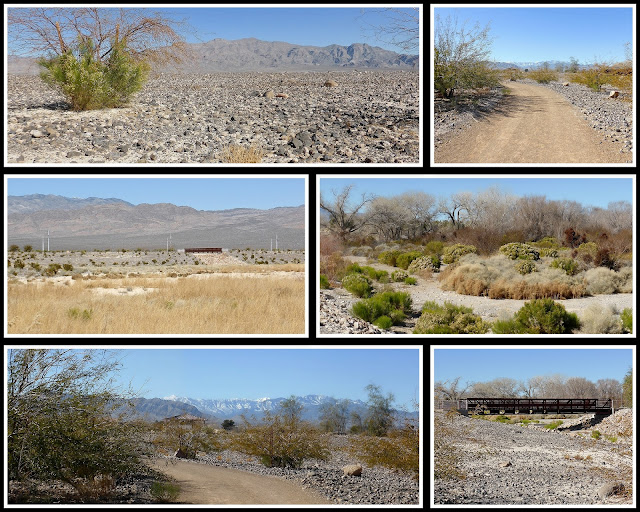{Click on an image to enlarge, then use the back button to return to this page}
This page last updated on 06/15/2017
 |
| (Fig. 01) |
Floyd Lamb Equestrian Trails - Background: Started in late of 2010, crews are still putting finishing touches on this $22 million Floyd Lamb Equestrian Trail project. Acting as an environmental flood-control facility designed to help alleviate severe flash flooding that can occur during heavy rains, there are two flood detention basins, 5.600 feet of concrete underground piping surrounding the main roads and 4.3 miles of hiking and horse trails with two bridges, natural foliage and dozens of shaded picnic areas (Fig. 02).
 |
| (Fig. 02) |
Funding for this project was provided by the Clark County Regional Flood Control District , the city of Las Vegas and the Bureau of Land Management through the sale of public lands as authorized by the Southern Nevada Public Lands Management Act. The new landscaping and the addition of green in the form of shrubs and trees have provided a new level of beauty making the entire area feel like there is life now in the desert (Fig. 01). Many people are already starting to enjoy this new area. In addition to people riding horses, people are walking dogs, hiking, and sitting, reading and picnicking and at the shaded table areas.
The work to date is only a small part of the 1,385 acres of desert, that was previously managed by the BLM and then leased to Floyd Lamb Park under the authority of the R&PPA (Recreation and Public Purposes Act. A portion of this land, known as the Northwest Equestrian Park, will house 320 acres of first-class equestrian facilities including arenas, trails, horse boarding, and host regional and national events.
On April 7th, the opening will be marked by a ceremony and ribbon cutting from 12-4 p.m. All are invited to come and hike the new trails. The event is also the councilman's annual Spring Fling , a free family-friendly afternoon of amusement park rides, jump houses, crafts, games, a farmers market, community vendors, live entertainment and more.
 |
| (Fig. 03) |
02/09/2016 Trip Notes: Today I visited Floyd Lamb Park with Bob Croke and Blake Smith. Our main reason for today's' visit was to hike the newly completed Floyd Lamb Equestrian Trails (Fig. 03) located out behind the main park area, a 680 acre area containing rolling green hills, 4 small natural spring fed lakes with ducks and peacocks, beautiful large trees, picnic areas and walking and horse riding trails. Starting from the Parking area, noted on (Fig. 02), we hiked the first (northern) outer parameter section of the horse trail, crossing over the first steel bridge. When we reach the end of this section, before it started to turn south, we decided to follow an unmarked used train that headed northeast (marked in green on the map in (Fig. 02)). Eventually we picked up another horse trail the headed south to the houses and the southern boarder of the boundary. hiking along the boundary along the housing development, we eventually followed a path that led back to the parameter trail that headed west to the second steel bridge that crossed over a wash that fed into the large "catch basin". After crossing over the bridge the trail headed north, back to our starting point. The total distance of our hike seen above was about 3.5 miles. After the hike we decided to drive back to the main portion of the park and have lunch in the picnic area overlooking Cottonwood Lake and Mulberry Lake. The pictures of the Canada Geese, cormorant, and turtle in the collage (Fig. 04) were taken while sitting at our picnic table eating lunch. After lunch we walked around the park looking for more picture opportunities. (Con't below)
 |
| (Fig. 04) |
First we went over to Tule Springs Lake, the largest of the park's four spring fed lakes (Fig. 10 below). We found a wide variety of waterfowl milling about the lake (Figs. 05 & 06). We then headed over to the historic area of the park and toured the many buildings that were once part of the original ranch. Tule Springs was the source of water supplying the daily needs of the early Paiute Indians and later stage coach lines that stopped here as they traveled across the desert. The oldest building on the property is an adobe building that was used as the stage coach stopped when the traveled through this area (Fig. 07). As we walked around this area we saw many peafowl that roam the property (Fig. 08). We also came across several rabbits that I had never seen here before (Fig. 09). Blake looked then up and found that they are Pygmy Rabbits (Brachylagus idahoensis). The small rabbits have short ears and a snub nose. The pygmy rabbit is believed to be one of only two Leporids (a family of mammals that include rabbits and hares)
, in Northern America that digs its own burrows. Pygmy rabbit burrows are typically found in relatively deep, loose soils of wind-borne or water-born origin. There main habitat is Northern NV and UT up into Montana and primarily in the Columbia Basin. We assume that they probably were left there as unwanted pets.
 |
| (Fig. 05) |
 |
| (Fig. 06) |
 |
| (Fig. 07) |
 |
| (Fig. 08) |
 |
| (Fig.09) |
 |
| (Fig. 10) |










